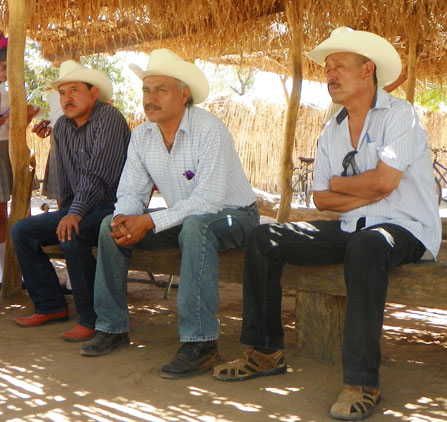Yaquis make progress in fight to recover tribal water

In Vicam, official Yaqui spokesperson Mario Luna Rojas (left) and tribal authorities announced the suspension of the highway blockade that has lasted eight months (Photo: Kenya Cuén).
VICAM
On Feb. 14, Yaqui tribal authorities announced a truce, ending the blockade that they had maintained on Highway 15 since May 2013.
The blockade of the Vicam section of the main highway between Mexico City and the border city of Nogales was in response to the plundering of water from the Yaqui River so that it could be piped to the state capital of Hermosillo via the Independencia Aqueduct.
“We want to demonstrate to the President that we are giving him the benefit of the doubt, since he has begun to comply with the convention signed this past Jan. 21 and is regaining our trust in his administration,” declared tribal authorities.
“Therefore, our tribal government, with the consensus of our people, has decided to declare a truce in our public protest on the international highway,” they said in front of representatives of the federal, state, and municipal governments.
The statement made reference to the agreements signed in the offices of the Secretary of the Interior in Mexico City. Prominent among these is restricting water delivery for Hermosillo to that which is designated purely for actual human consumption, as long as doing so does not result in the theft of water designated for the Yaqui.
“Given the advances made in complying with the January 21 convention, and in conjunction with our religious traditions, and the proposal to complete the consultation that was ordered by the federal Supreme Court, we are obliged to declare this truce,” they announced.
In attendance at the meeting in Vicam were David Korenfeld, the Director General of the National Water Commission (Conagua); Luís Alberto Padilla Aguilar, representative from the Secretariat of Agriculture, Livestock, Rural Development, Fishing, and Food; and the Undersecretary of the Interior, Luís Miranda Nava.
The Yaqui, in the words of its spokesperson Mario Luna, made it clear that their “unshakable fight for water has not ended. We are not giving up on our principles. At the same time we hope that the government will continue to comply fully with the spirit of the convention signed on January 21.
The policy of ignoring applied to the Yaqui by Guillermo Padrés, governor of Sonora, led to the intervention by other agencies. Padrés did not attend the meeting.
In recent months his administration has tried to break the unity of the Yaqui tribe through fraud and repression, all of which has been duly denounced.
Padrés has lost every legal case in which the Yaqui have responded in order to prevent him from further theft of the water to which they have had rights for more than 2500 years.
Construction of the Independencia Aqueduct began at the end of 2010 at a cost of US$306.35 million as a part of the Sonora Sí program to transport 75 million cubic meters per year of water from the Río Yaqui and the El Novillo reservoir to the Río Sonora basin.
The project would consist of 90 miles of steel pipe. It would travel through 5 municipalities: Hermosillo, Ures, Mazatán, Villa Pesquiera and Soyopa. Perspectives on the legal outcome favor the Yaquis, and there are a number of options for resolving the issue such as those contained in the Report on the Impacts Caused by the Implementation of the Independencia Aqueduct in Yaqui Territory.
Dated November 2013, it consists of 4 proposals: to increase the efficiency of the potable water delivery system in Hermosillo; to facilitate or increase graywater treatment, reuse and recycling; to acquire water rights and build aqueducts in the Río Sonora basin itself; and to build a sea water desalinization plant.
The proposed plant would have a production capacity of 660 gallons second, which is the equivalent of 75,000,000 cubic meters per year, and would use reverse osmosis technology. This would mean the construction of a 90 mile long counter slope aqueduct with a 203-foot elevation gain from the coast at Playa Cochorit in the municipality of Empalme.
The study was carried out as part of the project titled “Subordination, antagonism and autonomy within the sociopolitical movements in Mexico and Latin America” as part of the Research and Innovative Technology Projects Support Program (APIIAT) of the Department of Political and Social Sciences at the Autonomous University of Mexico.
